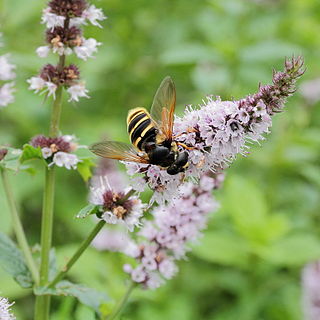
Mentha is a genus of plants in the family Lamiaceae. The exact distinction between species is unclear; it is estimated that 13 to 24 species exist. Hybridization occurs naturally where some species' ranges overlap. Many hybrids and cultivars are known.

Mimosa is a genus of about 600 species of herbs and shrubs, in the mimosoid clade of the legume family Fabaceae. Species are native to the Americas, from North Dakota to northern Argentina, and to eastern Africa as well as the Indian subcontinent and Indochina. The generic name is derived from the Greek word μῖμος (mimos), an "actor" or "mime", and the feminine suffix -osa, "resembling", suggesting its 'sensitive leaves' which seem to 'mimic conscious life'.

The Asclepiadoideae are a subfamily of plants in the family Apocynaceae. Formerly, they were treated as a separate family under the name Asclepiadaceae, e.g. by APG II, and known as the milkweed family.

Hepatica is a genus of herbaceous perennials in the buttercup family, native to central and northern Europe, Asia and eastern North America. Some botanists include Hepatica within a wider interpretation of Anemone.

The genus Pulsatilla contains about 40 species of herbaceous perennial plants native to meadows and prairies of North America, Europe, and Asia. Derived from the Hebrew word for Passover, "pasakh", the common name pasque flower refers to the Easter (Passover) flowering period, in the spring. Common names include pasque flower, wind flower, prairie crocus, Easter flower, and meadow anemone. Several species are valued ornamentals because of their finely-dissected leaves, solitary bell-shaped flowers, and plumed seed heads. The showy part of the flower consists of sepals, not petals.

Comptonia peregrina is a species of flowering plant in the family Myricaceae native to eastern North America. It is the only extant (living) species in the genus Comptonia, although a number of extinct species are placed in the genus.
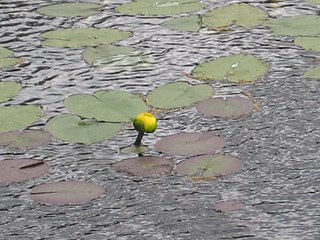
Nuphar is a genus of aquatic plants in the family Nymphaeaceae, with a temperate to subarctic Northern Hemisphere distribution. Common names include water-lily, pond-lily, alligator-bonnet or bonnet lily, and spatterdock.

Cynanchum is a genus of about 300 species including some swallowworts, belonging to the family Apocynaceae. The taxon name comes from Greek kynos and anchein, hence the common name for several species is dog-strangling vine. Most species are non-succulent climbers or twiners. There is some evidence of toxicity.
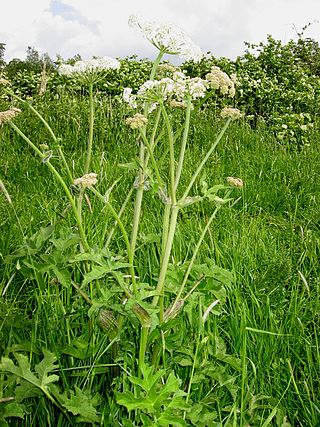
Heracleum sphondylium, commonly known as hogweed or common hogweed, is a herbaceous perennial plant in the carrot family Apiaceae, which includes fennel, cow parsley, ground elder and giant hogweed. It is native to most of Europe, western Asia and northern Africa, but is introduced in North America and elsewhere. Other common names include cow parsnip or eltrot. The flowers provide a great deal of nectar for pollinators.

Carpobrotus, commonly known as pigface, ice plant, sour fig, Hottentot fig, and clawberry is a genus of ground-creeping plants with succulent leaves and large daisy-like flowers. The name comes from the Ancient Greek karpos "fruit" and brotos "edible", referring to its edible fruits.

Stephania is a genus of flowering plants in the family Menispermaceae, native to eastern and southern Asia and Australia. They are herbaceous perennial vines, growing to around four metres tall, with a large tuber. The leaves are arranged spirally on the stem and are peltate, with the leaf petiole attached near the centre of the leaf. The name Stephania comes from the Greek, "a crown". This refers to the anthers being arranged in a crown-like manner.

Cardamine diphylla is a flowering plant in the family Brassicaceae. It is a spring flowering woodland plant that is native to eastern North America.

Anemone hepatica, the common hepatica, liverwort, liverleaf, kidneywort, or pennywort, is a species of flowering plant in the buttercup family Ranunculaceae, native to woodland in temperate regions of the Northern Hemisphere. This herbaceous perennial grows from a rhizome.
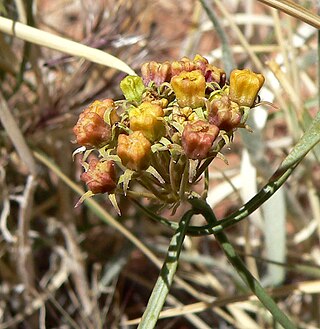
Funastrum utahense, synonym Cynanchum utahense, is a species of flowering plant in the genus Funastrum of the family Apocynaceae, known by the common names Utah swallow-wort and Utah vine milkweed. This relatively uncommon perennial vine is native to the Mojave Desert from California, Nevada, Utah and Arizona in the United States. This is a small vine with a highly branched, twining stem rarely exceeding a meter in length with which it physically supports itself on other shrubs and trees. It has small narrow leaves a few centimeters long. Its flowers are bright yellow to orange and grow in umbels. The fruit is a grooved follicle several centimeters long.

Dierama is a genus of flowering plants in the family Iridaceae. Common names include hairbells, angel's fishing rod, fairybells, and wandflowers in English and grasklokkies in Afrikaans. They are native to Africa, with most occurring in the southern regions of the continent. The center of diversity is the province of KwaZulu-Natal in eastern South Africa.

Caldcluvia is a monotypic genus in the family Cunoniaceae with the only species Caldcluvia paniculata, known as tiaca, an evergreen tree native to Chile. It is found from Ñuble to Aisén. Most species that were previously placed in the genus are now placed in Ackama, Opocunonia and Spiraeopsis.

Lumnitzera is an Indo-West Pacific mangrove genus in the family Combretaceae. An English common name is black mangrove. Lumnitzera, named after the German botanist, Stephan Lumnitzer (1750-1806), occurs in mangroves from East Africa to the Western Pacific, and northern Australia.

Ericoideae is a subfamily of Ericaceae, containing nineteen genera, and 1,790 species, the largest of which is Rhododendron, followed by Erica. The Ericoideae bear spiral leaves with flat laminae. The pedicel is articulated and the flowers are pendulous or erect, and monosymmetric, with an abaxial median sepal. The carpels are free and the anthers lack appendages. The capsule is septicidal.
Cynanchum gracillimum is a species of flowering plant in the family Apocynaceae. Under the synonym Adelostemma gracillimum, it was at one time the only species in the genus Adelostemma. It is native to Myanmar and China.
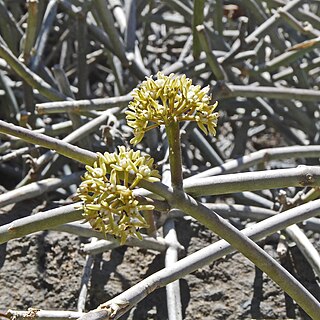
Cynanchum daltonii, synonym Sarcostemma daltonii, is a species of flowering plants of the family Apocynaceae. The species is endemic to Cape Verde. The specific name refers to Joseph Dalton Hooker. The species was named by Joseph Decaisne, as Sarcostemma daltonii, in 1849. Its local name is gestiba. The plant is used in traditional medicine to relieve and treat dental problems.


















